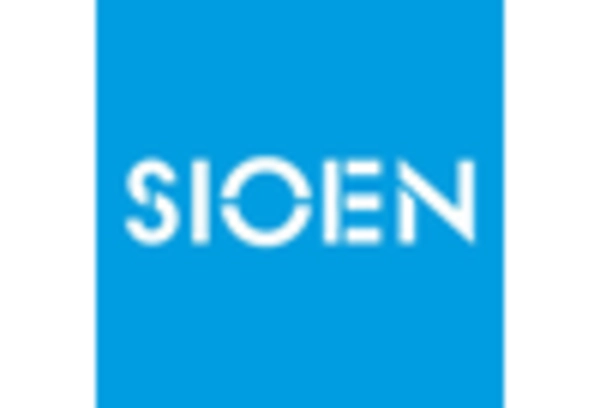Rising Demand in Automotive Sector
The automotive sector is experiencing a notable surge in demand for elastomer coated-fabrics, primarily due to their superior durability and resistance to environmental factors. As vehicle manufacturers increasingly prioritize lightweight materials to enhance fuel efficiency, elastomer coated-fabrics are becoming a preferred choice. The elastomer coated-fabrics market is projected to witness a growth rate of approximately 6% annually, driven by the need for high-performance materials in vehicle interiors and exteriors. Additionally, the trend towards electric vehicles, which often require advanced materials for battery enclosures and insulation, further propels the demand for these fabrics. This shift in the automotive landscape indicates a robust opportunity for manufacturers within the elastomer coated-fabrics market to innovate and cater to evolving industry standards.
Expansion in Industrial Applications
The industrial sector is increasingly adopting elastomer coated-fabrics for various applications, including conveyor belts, protective covers, and industrial curtains. These fabrics are favored for their strength, chemical resistance, and longevity, making them ideal for demanding environments. The elastomer coated-fabrics market is poised for growth, with an estimated increase of 5% in demand driven by the need for reliable materials in manufacturing processes. As industries continue to prioritize safety and efficiency, the adoption of elastomer coated-fabrics is likely to rise, presenting opportunities for manufacturers to innovate and expand their product offerings. This trend indicates a shift towards more resilient materials in industrial applications, further solidifying the market's position.
Growth in Outdoor and Sports Equipment
The outdoor and sports equipment sector is increasingly adopting elastomer coated-fabrics due to their exceptional weather resistance and flexibility. These fabrics are utilized in a variety of applications, including tents, backpacks, and outdoor apparel, where durability and performance are paramount. The elastomer coated-fabrics market is expected to expand as outdoor recreational activities gain popularity, with a projected growth rate of around 5% over the next few years. This growth is fueled by a rising consumer interest in outdoor activities and sports, leading to increased investments in high-quality gear. Manufacturers are likely to capitalize on this trend by developing innovative products that meet the specific needs of outdoor enthusiasts, thereby enhancing their market presence.
Increased Focus on Healthcare Applications
The healthcare sector is increasingly recognizing the benefits of elastomer coated-fabrics, particularly in medical devices and protective clothing. These fabrics offer excellent barrier properties, making them suitable for applications such as surgical gowns and drapes. The elastomer coated-fabrics market is anticipated to grow as healthcare providers seek materials that ensure safety and comfort for both patients and medical personnel. With the market projected to grow by approximately 4% annually, manufacturers are likely to invest in research and development to create specialized fabrics that meet stringent healthcare regulations. This focus on healthcare applications not only broadens the market scope but also enhances the overall value proposition of elastomer coated-fabrics.
Technological Innovations in Fabric Production
Technological advancements in the production of elastomer coated-fabrics are playing a crucial role in shaping the market landscape. Innovations such as advanced coating techniques and the integration of smart textiles are enhancing the performance characteristics of these fabrics. The elastomer coated-fabrics market is expected to benefit from these developments, with a projected growth rate of around 6% as manufacturers leverage new technologies to improve product quality and functionality. This focus on innovation not only meets the evolving demands of various sectors but also positions manufacturers to gain a competitive edge. As the market continues to evolve, the integration of technology in fabric production is likely to drive further growth and diversification.

















Leave a Comment